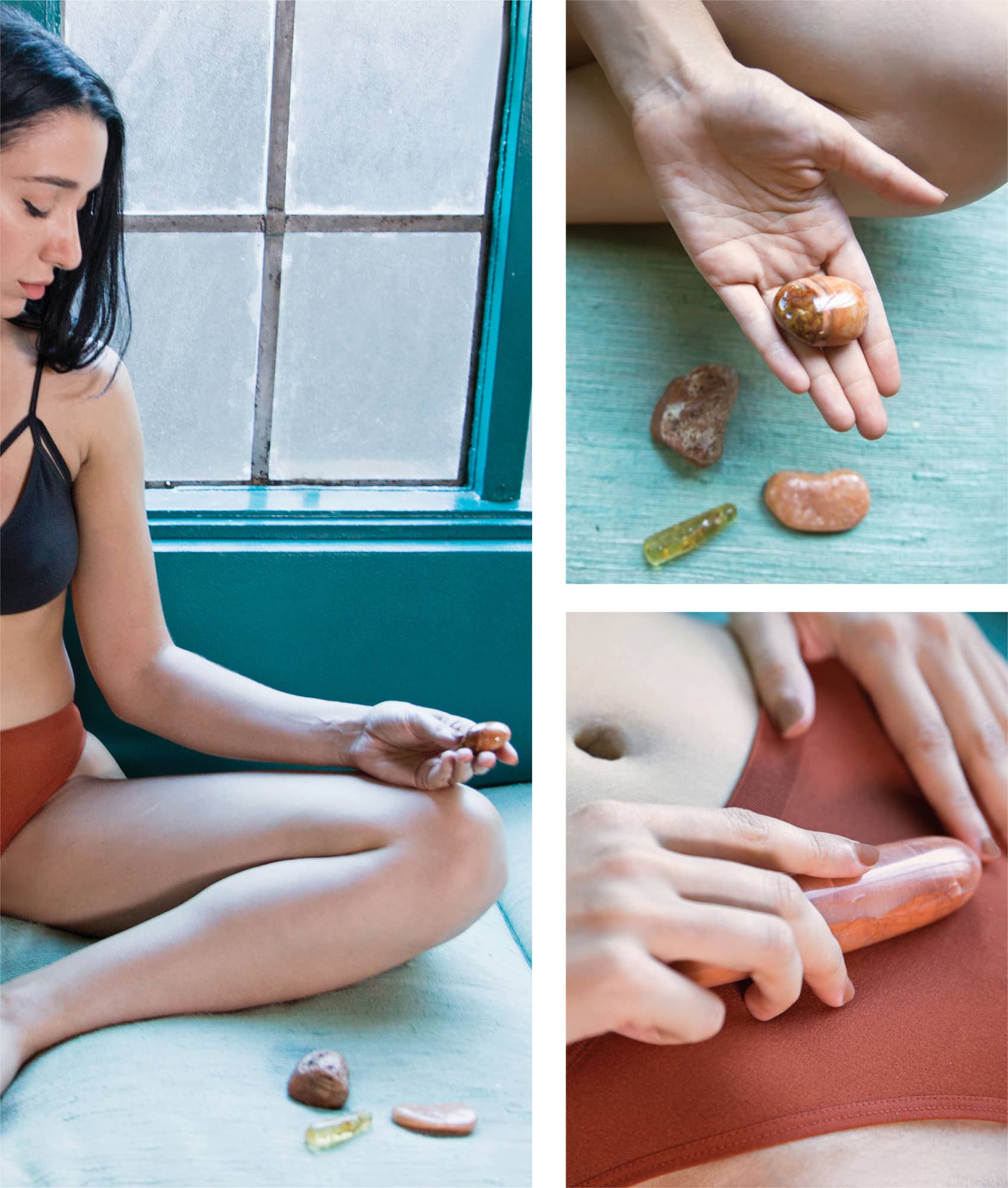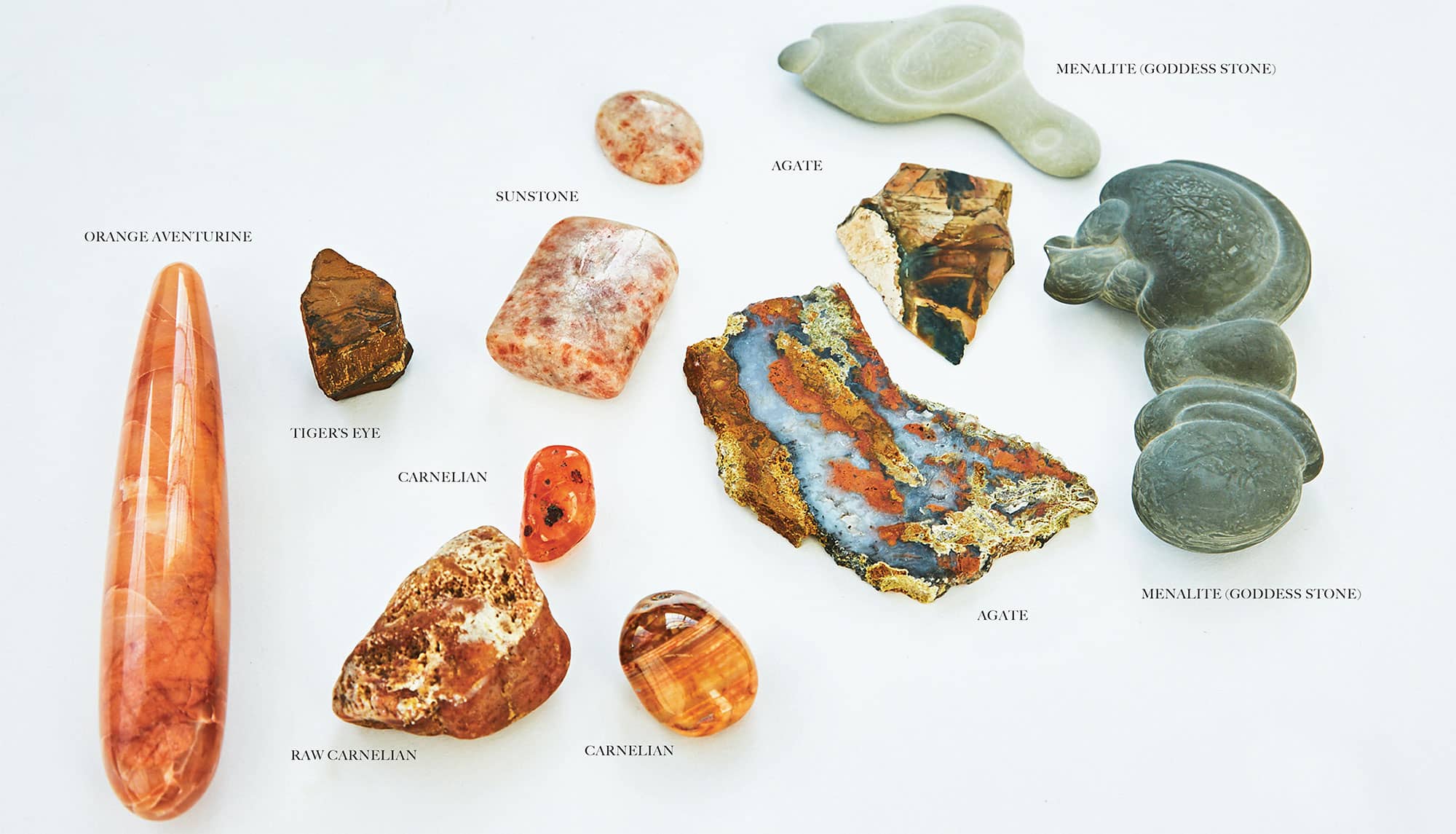7 THE SACRAL/SEX CHAKRA
The sacral or sex chakra’s symbolism relates to water energy, bringing nourishment and sweetness through exchange with those we love. It is associated with the lumbosacral nerve plexus and the gonads (the testes for male bodies and ovaries for female bodies). The pelvic area is also governed by this chakra.

As an archetype energy, the sex chakra is that of the Emperor/Empress. With it, we learn to take pleasure in what physical life has to offer, and we learn to feel worthy of its gifts. We learn the art of sacred indulgence while staying in touch with integrity, releasing guilt for whatever goodness we experience. The sacral chakra shows us that our bodies are vessels in which our spirits may explore the physical realm. This awareness lets us take pleasure in anything “human” we experience in our lives, giving us an appreciation not only for what feels good but for anything that alerts us to the reality of our bodies and emotions. When we feel sorrow, we appreciate it for the depth it is creating in our soul. When we feel pain, we appreciate it for the reminder that we are alive.
The sacral chakra is associated with taste but teaches us how to indulge in all the senses. Nourishing it helps us mindfully connect to all those senses, providing a deep gratitude for experiencing life through sight, smell, taste, sound, and touch.
The sacral chakra governs our emotional relationships to ourselves and to others. It allows us to feel passionate about life, bringing an awareness of the pleasure it is to be human. Because we appreciate ourselves as beings, we are able to see others in this light as well. Connecting to this chakra allows us to take pleasure in other people’s pleasure—a true key to fulfillment. When your sacral chakra is functioning in full health, you relate to everything with a sense of full connection. You feel empathetic, and you find it easy to be present and revel in the moment when receiving and giving sexual pleasure.
The sacral chakra rules our emotions, our creativity, and our sensuality. This is where our creativity resides. It is in tune with our creative force and our drive to create through feelings of connection and bondedness. The sacral and throat chakras are connected, as the throat chakra is what provides us the willingness to express our creativity. With a healthy sacral chakra, we can receive pleasure by providing pleasure, and we can understand that we provide pleasure through receiving.
A Healthy Sacral Chakra
When balanced and open, a healthy sacral chakra will make it easy to connect and form bonds with others and to feel naturally confident and outgoing. This chakra, when functioning properly, allows one to acknowledge others without envy and take joy in others’ free expression of their best selves. There is a presence of vitality in a person who is healthy in this center—someone with a general sensuality due to the ability to take pleasure in the little things. Sexual expression is conveyed with intense sensuality. This sensuality spills over into areas of life not just pertaining to sex but including everyday activities such as washing your face or eating breakfast.
When the Sacral Chakra Needs Acknowledgment
A common trauma associated with the sacral chakra is the lack of nurturing touch in childhood. Just as the root chakra highlights our primal need for sex in terms of procreation, the sacral chakra highlights the need for touch for touch’s sake. Affection is a necessity just like food or water. Arousal, just like hunger or thirst, can act as a signal that we are craving intimacy, that it is time to acknowledge our need for affection.
Rather than seeing arousal as an annoyance, like a headache you want to get rid of by taking medicine, try to see it as a call to action to bring more attention to yourself or a creative idea that you may be ignoring.
When this chakra is deficient in energy, sex becomes predominantly about orgasmic release and not about bonding or emotional connection; it signifies that energy is stagnant in the root chakra. Learning to move energy upward into the sacral chakra prevents sexuality from staying in a primitive state. Frigid bodies and beliefs, fear of change, and lack of desire are signifiers of a deficient sacral chakra energy.
If this chakra is in excess, addictions may arise. They may be addictions to sex, to romance, or to emotionally high and low relationships. A poorly functioning sacral chakra may be indicated by co-dependency and/or manipulation through seduction. Someone with an unhealthy sacral chakra has a sense of detachment that may come across to others as immaturity in relationships. In people with predominantly masculine energies, the sacral chakra can become damaged when the person is taught dysfunctional ideas about sexuality, pleasure, or emotion.
The Sacral Chakra and Spirituality
It is through the sacral chakra that I strengthened my idea of spirituality. Spirituality to me is being aware that you were here before you were born and that you will still exist after you die. For the time we are on this earth, we have this body to experience. When we connect to our spirit, we connect to the gift it is to be human. This gift includes having a relationship to the outside world, our senses, and our emotions—and perceiving them through a lens of gratitude. Taking pleasure in all that being a human encompasses is a way to show gratitude for the life you have been given. Gratitude is a transcendent emotion, and when applied to all we undergo as humans, it alters our state of consciousness.
Being rooted in this pleasure center shields you from negativity. When you are connected to your pleasure and integrate it with your values, a sense of confidence and worthiness of that pleasure prevents you from feeding into the antagonistic attitudes of those around you; you are too focused on what is true for you. Aligning yourself with this sense of worthiness by fostering a healthy relationship with sexuality affects other areas of your life, too. You become cognizant of the benefits of releasing guilt associated with feeling good.
The Gift of Nature:
SACRAL CHAKRA EXERCISE
Because this center focuses on being in tune with subtle pleasures and taking deep joy in them, this exercise will focus on light clitoral stimulation.
The clitoris is the only organ on the body that’s only purpose is pleasure. As such, it is the perfect place for honoring the sacral chakra—the chakra dedicated specifically to the pleasurable aspects of sexuality. The clitoris, like every other part of the vulva, is different on every body. Most people think of it as the little hooded part at the top of the vagina, but it is actually made up of four parts: the clit tip, the prepuce (sometimes referred to as the “clitoral hood”), the body (shaft), and the legs—the full shape is much like that of a wishbone. When not aroused, the clit tip is on average about half a centimeter long. This tiny area is filled with 8,000 nerve endings, and the surrounding areas add even more, which is why the area is so pleasurable to touch.
The full size and scope of the clitoris wasn’t discovered until 1998, when urologist Helen O’Connell began studying it using MRI. She was able to prove that much of the clitoris’s anatomy—about 4 inches (10 cm) of it—is actually inside the pelvis. When a woman becomes aroused, the clitoral legs swell around the vagina, creating a cuff that is stimulated with pleasure. This information has challenged our understanding of vaginal orgasms, as we now know that orgasms achieved through penetration are often a type of clitoral orgasm.
The word clitoris comes from the Greek root word kleitoris, which translates to “godly” or “goddess-like.” Touching this spot is perfect for increasing the transcendental feeling of gratitude for life by indulging in the joy of this gift of nature.
TIP: You may wish to start with the labia massage explained in the Root Chakra Ritual as a warm-up.
Create your space for this exercise. First, make sure your hands are thoroughly cleansed with mild, gentle soap. Because you will be lying flat on your back, create a nesting place on your bed or floor. Keep your Chakrub, yoni egg, or sacral crystal nearby. Start by stating your sacral chakra intention. For example, “I feel connected and love for my body,” or simply, “I feel.” For this exercise, start completely naked, or undressed from the waist down, if you choose to do the sensual touching aspect of this exercise.
TIP: If you don’t have a clitoris or wish to open/heal the sacral chakra, you can place the orange crystal of your choice on the area 4 inches (10 cm) below your navel and perform the non-sensual touching parts of this exercise.

Choose Your Crystals
Crystals for this exercise will ideally be orange or peach in color. A Chakrub or yoni egg is best, though to receive the support of another crystal, you can hold it in your less dominant hand while performing the massage with your dominant hand. Follow the steps below, but make it your own. This practice will last about 15 minutes, but can go as long as you’d like.
1. Sit with the soles of your feet touching (you may wish to sit on a blanket or pillow for added comfort). This is a butterfly pose, which will call in transformative animal energy. Hold your sacral chakra crystal in your less dominant hand and begin to mindfully breathe in through the nose, out through the mouth. You may also sit in a comfortable chair, if you prefer.
2. Tune in to the energy of the crystal. Imagine it is connected to your sacral chakra, the area about 4 inches (10 cm) below your navel. Visualize the crystal residing there, glowing in a beautiful sunset orange.
3. Take note of any changes in sensation you feel. Do you feel heat, coolness, or tingling sensation?
4. Gently lay down on your back, keeping the soles of your feet touching. Continue to breathe.
5. Place your crystal on the sacral chakra area and deepen your breath to meet the crystal in your lower stomach. Continue this breathing.
6. Once you feel ready, move your yoni egg or Chakrub to your dominant hand and touch it lightly to your clitoris. If you do not have a yoni egg or Chakrub, continue to hold the sacral crystal over your sacral chakra with your less dominant hand, and touch the area with your dominant hand. Optional: Before making physical contact with this area, grab a mirror and observe it without judgments. If you choose to do this, take your time as if you were “eye-gazing” with this part of yourself.
7. With ever-so-slight pressure (like the wings of a butterfly), touch the area to the right of the clitoris, and see if you can strengthen the sensation by feeling the energy of the crystal.
8. Repeat on the left side of the clitoris. Try moving in circles, strokes, or whatever feels good. Remember to breathe.
9. Be mindful of any sensations you feel. Imagine the energy you created moving up to your sacral chakra. Visualize the orange sunset glow in your chakra glowing brighter and brighter. You may choose to say the sensual sound associated with this chakra, “oo.”
10. Rest your crystal on your sacral chakra.
11. Optional: Because the sacral chakra is associated with sense of taste, you may wish to end this exercise by tasting yourself.

Crystals for the Sacral Chakra
The sacral chakra is associated with the color orange, and because its element is water, it could also take the color of very light blue or white in more rare occasions. Crystals of this color will strengthen this chakra and can be used to strengthen creativity, bring light and levity to serious situations, and strengthen long-term commitments.

Carnelian
Carnelian is a brilliant, orange or red-colored variety of chalcedony that’s name is derived from the Latin word for flesh. Ancient Egyptians associated this stone with the fertile menstrual blood of the mother goddess, Isis. That’s fitting, as carnelian is known to stimulate blood flow and influence the reproductive organs of both sexes.
BENEFITS:
Traditionally used to enhance passion, love, and desire
– Known as the “Singer’s Stone,” it clarifies the voice
– Used for the consummation of love and to rekindle passion
– Restores vitality and stimulates creativity
– Evokes confidence and helps overcome sexual anxieties and eating disorders
– Protects against envy, rage, or resentment from yourself and others
Sunstone
Sunstone is a joyful stone named for its warm shades of red, orange, gold, and brown that sparkle like the sun. It carries the energy of Ra, the sun god, whose radiant energy brings all potential life from within the Earth.
BENEFITS:
Inspires the nurturing self and to be of service to others
– Inspires leadership and personal power
– Reflecting the qualities of light, stimulates openness, warmth, and generosity
– Provides strength to those dealing with loss or emotional dependence
– Vitalizes and energizes while stimulating self-healing powers
– Removes hooks from possessive loved ones or lovers
– Helps strengthen resolve for those who have difficulty saying no
– Can acts as an antidepressant for those with seasonal affective disorder
Orange Aventurine
Orange aventurine is sometimes called the “Whisper Stone” because it can quiet a critical inner voice and promote self-love. It is a powerful stone of good fortune and helps align its wearer with their highest vibration.
BENEFITS:
Promotes feelings of calm and balance
– Stills the mind during meditation
– Helpful for dealing with issues of self-worth and increasing confidence
– Promotes creative problem solving to overcome challenges
– Promotes clear communication and enhances intellectualism
– Manifests new opportunities and encourages ideas
– Helps with healing from sexual trauma
Tiger’s Eye
Tiger’s Eye is a balancing stone that synthesizes the energy frequencies of the sun and earth. An ancient talisman revered by many cultures, tiger’s eye has been called the “all-seeing and all-knowing eye” for its ability to give its wearer greater insight and observational skills. Egyptians gave their deity statues eyes made with tiger’s eye to symbolize divine wisdom.
BENEFITS:
Invokes compassion and practicality in decision-making
– Wards off complacency and stimulates an open mind eager to try new things
– Helps piece together fragmented information
– Inspires creativity and utilizing one’s talents
– Sharpens vision and provides a bird’s-eye view of situations
– Stimulates personal will to help break bad habits or addictions
– Sparks imagination and intuition and can assist in dream recollection
Menalite (goddess or fairy stone)
Menalite occurs naturally by forming in Quaternary deposits left in lakes by receding glaciers. Native Americans have referred to them as “fairy stones” for centuries and carried them for good luck and protection against negative entities. Today we call menalite the goddess stone, as it enhances our connection with the divine feminine. Its formations are unusual and often recall animals and goddess-like carvings.
BENEFITS:
Boosts intuition and creative and manifestation powers
– Creates a connection to wise feminine and goddess energy
– Can be used for shamanic journeying and astral travel
– Balances masculine and feminine energies
– Restores connection to the earth and grounds energy
– Calls forth the energies needed to realize one’s purpose in this lifetime
– Emphasizes the naturally occurring life cycles of rebirth and reincarnation
– Provides support when dealing with loss or death
– Supports fertility, menopause, menstruation, and lactation
Agate
Referred to as the “earth rainbow” for its beautiful banded layers and stripes, agate has been used for healing dating back to the times of Babylon. Some agates have markings that appears like eyes. Throughout history there are reports of agate revealing divine figures in its natural veining, such as the Virgin Mary, Jesus, John the Baptist, and angels. These natural works of art are still celebrated in various churches and museums throughout the world today.
BENEFITS:
Vibrates at a lower frequency that contains a stabilizing and strengthening influence
– Harmonizes yin and yang and balances emotional energy
– Removes desire for things we don’t need
– Can be used as a support crystal during pregnancy and postpartum to avoid depression
– Promotes fidelity within committed relationships
– Encourages realistic and pragmatic thinking
– Helps one overcome bitterness and negativity by healing anger and fostering love
– Useful for overcoming trauma
– Helpful in identifying circumstances that are detrimental to one’s well-being